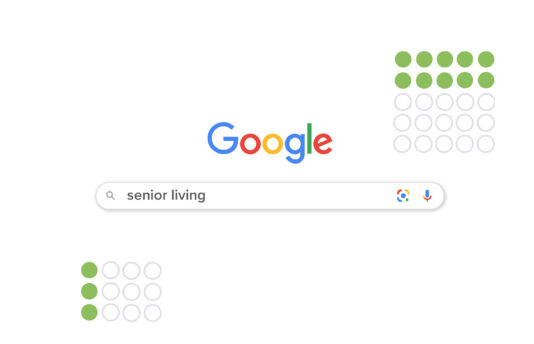As the U.S. population continues to age, more and more seniors are considering senior living communities as an alternative to staying at home. In this decision-making process, adult children play a crucial role.
According to a survey conducted by Caring.com, adult children are involved in the process of both finding and moving their parents to senior communities 73 percent of the time. The survey also found that when adult children fill in an independent living lead form for a parent, the move-in rate is 3.5 times higher than when the prospective resident makes the online inquiry themselves. This makes adult children of seniors a key target for your community’s marketing efforts.
In addition to digital tactics such as PPC, SEO, email and social media, native advertising and direct mail are effective in getting your senior living community in front of this valuable audience.
1. Native Advertising
Native advertising is a powerful digital marketing strategy that offers several advantages. Essentially the digital equivalent of a print advertorial, native ads are a type of sponsored content that seamlessly blends in with the website or platform where they are placed. Data shows that users trust content in an editorial environment more than on social media. This type of advertising is less disruptive to the user experience since it doesn’t look like a typical ad.

There are several advantages to native advertising, including:
- The ability to actively target and engage your audience with relevant and valuable content. Custom targeting allows marketers to segment people looking for living options for their aging parents.
- They are easier to understand than display and social ads and are viewed more often than banner ads. This is because they are contextually targeted to match similar content the end user is already consuming.
- They have a higher click-through rate, are more easily remembered and have greater reach and more conversions than other advertising methods.
How to Craft Compelling Content for Native Ads
With native advertising, the content is as important as the creative and almost as important as your targeting.
First, identify the audience’s pain points: concerns about the quality of care, cost of senior living communities, senior safety and variety of amenities and programs, to name a few.
Next, use native ads to address those pain points and help adult children better understand what a senior community offers and how it will benefit their parent(s). For example: “Are Your Aging Parents Having Trouble with Home Maintenance? A Continuing Care Retirement Community Eliminates Home-Ownership Hassles and Provides a More Carefree Lifestyle.” An article on that topic identifies the concern and offers a solution.
Finally, a call to action within the ad can make it clear to the audience what to do next, such as learning more on a landing page with an information request form.
Best Practices for Native Ads
Error-Free Writing
Since native ads are likely placed alongside professionally written articles, the content must be readable and free of grammar and spelling errors, or it will not blend with the rest of the page content.
Proper Placement
Make sure your content matches the placement. For example, an informational piece about what to look for in senior communities may not mesh well with a humor site. Native ads should not only match the look of the environment but also the feel.
Attention-Grabbing Images
Include high-quality images that are eye-catching. For example, photos of the community and the real people who live there rather than stock photos, big logos or illustrations will appeal more to readers.
Accurate Audience Targeting
It’s critical to know your target audience and understand the needs and preferences of adult children (specifically Gen X and Baby Boomers) to create content that will resonate with them. That means:
- Reach your audience where they live. Discover what platforms adult children are likely to go to for information, whether blogs, online news publications or social networking websites. Facebook, Instagram and YouTube are among the demographics’ go-to social media sites. Need help? Check out our Media Matrix to learn more.
- Leverage targeting options, such as age, interest and location. Native advertising placements allow for contextual targeting options that are almost endless.
- Take advantage of retargeting. With retargeting, if a visitor views a landing page but doesn’t act, you can serve a display ad to them while they’re browsing to remind them of their interest and drive them back to the site.
2. Direct Mail
When it comes to reaching adult children of seniors, it’s important to introduce both digital and traditional media methods into your marketing strategy. Traditional tactics like direct mail are very influential with the two generations that are essential to your marketing efforts: Gen X and Baby Boomers.
Despite today’s “digital-first” mentality, direct mail remains incredibly valuable in senior living marketing efforts.
According to USPS:
- Fifty-seven percent of Baby Boomers and 45 percent of Gen X say they’d be disappointed to no longer receive mail.
- Seventy-one percent of Baby Boomers and Gen Xers feel mail is more personal than digital communications.
- Gen Xers are more likely to read promotional mail than emails.
- They’re also the generation most likely to use a QR code.
Why Direct Mail Works
Direct mail is targeted, customizable and personalized and can generate a strong response from the target audience.
Overall, direct mail:
- Has an average response rate that’s four to eight times that of email.
- Has a 29 percent median ROI compared to 23 percent for paid search and 16 percent for online display.
Also in direct mail’s favor: 42.2 percent of direct mail recipients either read or scan the mail they get, and most households keep advertising mail for 17 days on average.
Advantages of Direct Mail
- It is not subject to the same privacy regulations that digital marketing channels are, such as the GDPR and CCPA.
- Senior communities can target their audiences based on specific demographics, such as age, income and geographic location.
- Mail personalized with the recipient’s name, specific interests and concerns creates a more personal connection with the reader, increasing the likelihood of a response.
- Direct mail pieces are physical, tangible items, making the message more memorable and effective and increasing the likelihood of a response. It’s also highly shareable amongst family members—a direct mail piece addressed to one household member may reach four or five people.
Ways to Use Direct Mail to Target Adult Children
Invites to Events & Tours
Use direct mail to invite adult children and their parent(s) to an informational or social event or personal tour using a direct mail piece with a QR code. You can even invite just the adult children so they can get to know the community and then influence their parent(s).
Creating Multiple Touchpoints
You may have heard that it takes an average of eight touchpoints to make a sale, but that number is much higher regarding decisions about senior living communities: It can take as many as 25 or more touchpoints from initial inquiry to move-in. Direct mail is an eye-catching, quick and personalized touchpoint to get you started.
Segmented Targeting
Develop or buy a mailing list with the adult child’s and parent’s information. Even if the child is in Maine and the parent is in Florida, you can create segmented mailings customized for each audience, whether you’re targeting Florida retirees for a senior community in Maine near their children or Maine children for a community near their parent(s) in Florida.
Measuring ROI
Unlike most traditional marketing tactics, one of the most significant advantages of digital marketing is that you can track almost anything. However, that doesn’t mean there’s no way to track return on investment with direct mail. For example, you can track the following:
- Using a dedicated QR code, you can calculate the click-through rate with the number of mail pieces sent and the number of people who went to the landing page.
- With the number of people who viewed the landing page and responded via a form fill, you can track the conversion rate.
- You can learn about visitors’ interests by tracking whether they went to other pages on the website, how long they remained and what pages they viewed.
Maintaining the Marketing Mix
Knowing that adult children often act as influencers in their parents’ decisions about senior living communities makes them an essential target audience when marketing your community.
Digital marketing via PPC, SEO and social media is effective, but that doesn’t have to be the extent of your efforts. Less common ways of reaching adult children of seniors, including native advertising and direct mail, can and should be part of your overall marketing mix.











